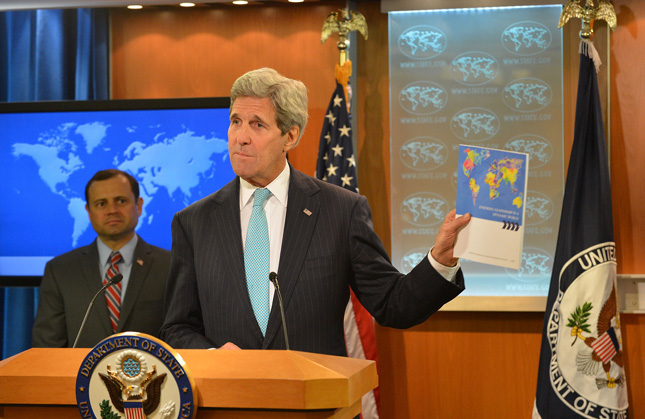-
In Kerry’s Quadrennial Diplomacy and Development Review, Climate and Conflict Are Focus
April 29, 2015 By Schuyler Null
It’s a bit late, but the second-ever Quadrennial Diplomacy and Development Review (QDDR) is finally here. And it’s a good thing – it’d be a shame if this effort to present a coherent strategic narrative of U.S. diplomacy and development, which was started by Secretary of State Clinton in 2010, petered out.
After the first QDDR in 2010, which was framed in terms of “elevating civilian power to be a better partner” to the U.S. military, this one stands on its own, presenting a more united front from the Department of State and USAID.
The overall focus is on achieving flexibility and adaptability for a “dynamic world.” But in the foreword, Secretary Kerry also says it “does not seek to be everything to everybody…because most of all, we intend to make it relevant.” As such there are four major pillars: conflict and violent extremism, climate change, inclusive economic growth, and democracy.
Ensuring Climate Integration
Thoroughly integrating climate change into State and USAID’s activities has been a priority of Secretary Kerry since he joined the department, starting with one of his first policy memos. His approach is laid out in even greater detail here. According to the QDDR, State is to establish a new working group on climate resilience to ensure climate integration takes place. State and USAID are also to designate critical countries for “in-depth climate engagement,” including those most vulnerable to its impacts, but also those with “key roles to play in reducing greenhouse gas emissions” and those that “can influence neighboring countries to meet international climate goals.”
State is to establish a new working group on climate resilienceIn line with improving flexibility, State and USAID’s climate efforts are supposed to “go beyond capitals” to engage with non-state actors, like mayors and governors, business leaders, faith leaders, and women’s groups – an approach we have frequently discussed here and long-championed by Wilson Center Scholar Ruth Greenspan Bell.
Getting Ahead of Violent Extremism
The effects of climate change are already being seen – extreme weather is estimated to have cost the United States $110 billion in 2012 – and impacts are expected to increase as temperatures rise. These changes may translate as a “threat multiplier” in vulnerable or fragile regions, increasing the potential for violence. Citing the 2015 National Security Strategy, the QDDR calls climate change an “urgent and growing threat to our national security, risking increased natural disasters, refugee flows, and conflicts over basic resources like food and water.”
While conflict between states has declined in recent years, civil wars have increased and violent extremism has emerged as a key threat. The QDDR instructs State and USAID to find new ways to build peace in this changing context, including developing a new strategic framework for fragile states based on the New Deal for Engagement with Fragile States. It also calls for aligning this framework with the U.S. National Action Plan on Women, Peace, and Security, which recognizes the often unique position of women and girls during crises, both as untapped peacebuilders and particularly vulnerable populations. This new framework would be triggered automatically to provide guidance on support and personnel needed to avoid conflict when a crisis emerges. As in the OECD’s recent report on aid to fragile and conflict-affected states, the QDDR prioritizes efforts to improve political legitimacy, security, economic foundations, and revenues/services in these contexts.
Climate resilience coming into its own as a pillar of foreign policyTo “get ahead of the next ISIL,” Kerry’s QDDR makes combatting violent extremism a key priority. The report calls for an enhanced role for USAID through the establishment of a new Secretariat on Countering Violent Extremism, as well as providing U.S. support for the Global Counterterrorism Forum, established in 2011.
There’s a lot more in the 2015 QDDR and many hints at the direction of U.S. aid and diplomacy, particularly in terms of addressing climate change and conflict. “The QDDR goes beyond simply recognizing the link between climate and security by outlining concrete steps to make U.S. development and diplomatic efforts climate sensitive,” says Wilson Center Director of Population, Environmental Security, and Resilience Roger-Mark De Souza. “The call for integrating climate resilience, disaster risk reduction, and climate mitigation into all development assistance echoes the G7 Foreign Ministers’ recent agreement to better understand the compound risks posed by climate change and instability. With these two important statements, climate resilience is coming into its own as a pillar of foreign policy.”
Sources: Center for Climate and Security, U.S. Department of State.
Photo Credit: Secretary Kerry holds up the 2015 QDDR at its launch in Washington, DC, courtesy of the U.S. Department of State.
 A Publication of the Stimson Center.
A Publication of the Stimson Center.



